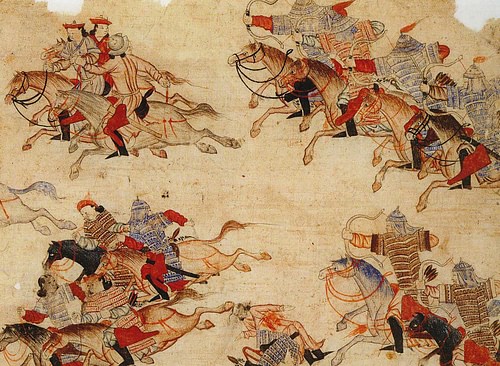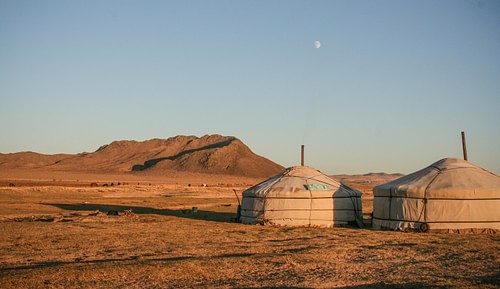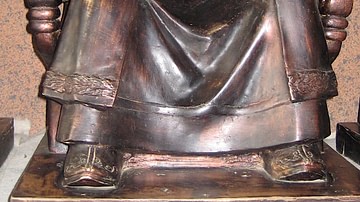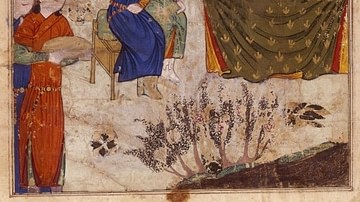
The Mongol Empire (1206-1368) was founded by Genghis Khan (r. 1206-1227), first Great Khan or 'universal ruler' of the Mongol peoples. Genghis forged the empire by uniting nomadic tribes of the Asian steppe and creating a devastatingly effective army with fast, light, and highly coordinated cavalry. Eventually, the empire dominated Asia from the Black Sea to the Korean peninsula.
Expert horsemen and archers, the Mongols proved unstoppable in Central Asia and beyond, defeating armies in Iran, Russia, Eastern Europe, China, and many other places. The descendants of Genghis each ruled a part of the empire - the four khanates - the most powerful of which was the Mongol Yuan Dynasty in China (1271-1368), established by Kublai Khan (r. 1260-1279). Eventually, the Mongols became part of the sedentary societies they had so easily overwhelmed and many converted from traditional shamanism to Tibetan Buddhism or Islam. This was a general symptom of the Mongols not only losing part of their cultural identity but also, too, their famed military prowess, as the four khanates all succumbed to damaging dynastic disputes and the armies of their rivals. Although not famed for creating any lasting architectural wonders or political institutions, the Mongols did make the significant contribution to world culture of finally connecting the eastern and western worlds via expanded trade routes, diplomatic embassies and the movement of missionaries and travellers from Eurasia to the Far East.
Nomads of the Steppe
The Mongols were pastoral nomads of the Asian steppe who herded sheep, goats, horses, camels, and yaks. These tribes moved according to the seasons and lived in temporary camps of circular felt tents or yurts (gers). The climate of Mongolia is often harsh and, reflecting this, clothing was warm, durable, and practical. Felt from sheep's wool and animal furs were the most common material to make clothing which was remarkably similar for both men and women: heelless boots, baggy trousers, a long jacket-robe (deel) worn with a leather belt, and a conical hat with earflaps, while underclothes were made from cotton or silk.
The Mongol diet was mostly dairy-based with cheese, yoghurt, butter, and dried milk curds (kurut) being staples. A mildly alcoholic drink, kumis, was made from mare's milk which was often drunk to excess. The herds being too valuable as a sustainable source of milk, wool, and even dung for fuel, meat was typically acquired through hunting and wild fruits and vegetables were gathered through foraging. To stock up for winter and provide meat for special feasts such as at the irregular tribal gatherings, special hunts were organised. At these events a strategy known as the nerge was employed where riders encompassed a huge area of steppe and slowly drove the game - anything from marmots to wolves - into an ever-smaller area where they could be more easily killed by mounted archers. The techniques, organisation and discipline of the nerge would serve the Mongols well when they went to war. Most of these features of medieval daily life in the Mongol world are still continued today by steppe nomads across Asia.
Although nomadic life generally saw men do the hunting and women do the cooking, the division of labour was not always so clear, and often both sexes could perform the tasks of the other, including using a bow and riding. Women tended animals, set up and packed away camps, drove the tribe's wagons, looked after the children, prepared foodstuffs, and entertained guests. Women had rather more rights than in most other contemporary Asian cultures and could both own and inherit property. Several women even ruled as regents in the spells between the reigns of the Great Khans. Another area of Mongol life where women were actively involved was religion.
Religious Beliefs
The Mongols' religion had no sacred texts or particular ceremonies but was, rather, a mix of animism, ancestor worship, and shamanism. Instances of the elements of fire, earth, and water, impressive geographical sites like mountains and natural phenomena such as storms were considered to possess spirits. Shamans, who could be both men and women, were thought able to, in a state of trance, communicate with these spirits and travel in their world, helping to find lost souls and divine future events.
Other religions were present amongst the Mongols, notably Nestorian Christianity and, from the 14th century, Tibetan Buddhism (Lamaism) became popular, perhaps thanks to its shamanistic elements. Islam was also widely adopted in the western khanates. Above all, though, there was a widespread belief in the principal two deities: the Earth or Mother goddess, known as Etugen (Itugen), who represented fertility, and Tengri (Gok Monggke Tenggeri), the 'Blue Sky' or 'Eternal Heaven.' This latter deity was seen as a protector god and, crucially, he was thought by the tribal elites to have given the Mongol people a divine right to rule the entire world. Genghis Khan and his successors would put this idea into devastating practice by conquering almost the entire continent of Asia and creating the largest empire ever seen up to that time in history.
Foundation By Genghis Khan
The Mongol nomadic tribes were then, used to a tough life, were highly mobile by nature and were trained from childhood to ride horses and shoot bows. These qualities would make them into excellent warriors able to endure long and complex campaigns, cover vast amounts of territory in a short space of time and survive on only the absolute minimum of supplies. Even the role of women and their chores of camp-making and transportation helped the Mongol army as they provided the vital logistic support for their husband warriors. Genghis Khan was perhaps the first Mongol leader to realise that if only the various tribes and clans could be united, the Mongols could master the world.
Genghis, born Temujin c. 1162, overcame a harsh childhood of abandonment and poverty and established himself as an able military commander for Toghril, chief of the Kerait tribe. The life and times of Genghis are told in The Secret History of the Mongols, a 13th-century chronicle which is our best primary source for the early empire. Over a period of around 10 years from 1195 to 1205, Genghis became a leader in his own right and slowly expanded his domain through a ruthless mixture of diplomacy, warfare, and terror - for many warriors it was often a case of join the young leader or be executed. Tribes such as the Tartars (a name medieval westerners wrongly applied to the Mongols themselves), Kereyids, Naimans, and Merkids were brought into line. Finally, in 1206 in a grand meeting of all tribal leaders (a kurultai), Genghis Khan (aka Chinggis Khan) was formally recognised as the Great Khan or 'universal ruler' of the Mongols.
The Khan attempted to further unify his realm by insisting that the hitherto only spoken Mongol language was made into a written one using the script of the Uighur Turks and by introducing a lasting law code, the Yasa. Communication was greatly helped by the establishment of the Yam, a network of staging posts which messengers could use for resupply as they rode across the state. The empire had already begun in earnest but it was about to get a whole lot bigger.
Expansion: Northern China & Persia
Mongol tribal leaders had traditionally achieved and then maintained their position of power by distributing war booty amongst their loyal followers and Genghis was no different. The Mongol army was based around a core 10,000 men, which was the khan's personal bodyguard, the kesikten. Members of this elite would also hold key administrative positions across the empire. Additional troops were gained through conscription of the Mongol tribes and contingents from allies and conquered territories. The main offensive weapon was the light cavalry with its riders expert at firing the powerful Mongol composite bow. Mongol horses were another asset both for their sturdiness and stamina, but also their sheer numbers, allowing riders up to 16 spare mounts which meant an army could travel huge distances with great speed.
Genghis' first target after becoming Great Khan was the Jin state (aka Jurchen Jin Dynasty, 1115-1234) in northern China. The speed of the Mongol cavalry and the terror tactics when dealing with captured cities reaped dividends, and the internally fractured Jin state was forced to retreat to the south. A simultaneous target was the Tangut state of Xi Xia (aka Hsi-Hsia, 1038-1227), also in northern China and similarly incapable of stopping Genghis' relentless progress across East Asia. The third target in this period was Song Dynasty China (aka Sung, 960 - 1279). Richer and more powerful than its neighbours, the Song proved more resilient, despite Genghis sacking many of their cities, but their time would come. By 1219, even northern Korea had been attacked as Genghis chased down the troublesome Khitan tribes who had fled there.
Seemingly intent on earning his title as 'universal ruler', Genghis now turned his attention to western Asia. From 1218, the Persian Khwarazm Empire was attacked. A Mongol army of 100,000 men swept all comers aside, capturing such notable cities as Bukhara and Samarkand. In 1221 the Mongols swept into northern Afghanistan, in 1223 a Russian army was defeated at Kalka, and then the Caspian sea was entirely encircled as the army returned home. The Muslims of the region now had a new title for Genghis, the 'Accursed One.' Cites had been destroyed down to their foundations, civilians were massacred, and even irrigation systems were wrecked. The Asian world had been turned upside down in less than two decades. Genghis Khan died on 18 August 1227 of an unknown illness, but his successors would ensure the Mongol new world order would far outlast its creator.
Ogedei Khan Attacks Europe
Genghis had decreed that his empire was to be divided amongst his four sons Jochi, Chagatai (Chaghadai), Tolui (Tului), and Ogedei (Ogodei), with each ruling a khanate (although Jochi would predecease his father in 1227). Ogedei became the new Great Khan (r. 1229-1241) and thus ruler of all the Mongols. The unified empire would endure until 1260 CE when the four khanates became fully autonomous (see below).
Ogedei Khan further consolidated the Mongol state apparatus by appointing members of the imperial bodyguard and ministers as regional governors (daruqachi), conducting a census and imposing a proper tax system (as opposed to the mere confiscation of property). In 1235, a capital was selected, Karakorum (Qaraqorum) in Mongolia. The Yam network was expanded, wells were protected along trade routes, and travelling merchants were given military protection.
In terms of conquests, Ogedei carried right on where his predecessor had left off and, with the help of the gifted general Subutai (aka Sube'etei, 1176-1248), known as one of the 'Four Hounds' of the khan, campaigned against the Jin in 1230-1. The Jin capital of Kaifeng fell in 1233, and the campaign of 1234 brought about the suicide of the Jin emperor, Aizong (r. 1224-1234) and the total and final collapse of the Jin state. Korea was repeatedly raided in this period, too.
From 1235 Subutai coordinated the campaign across Central Asia, capturing such cities as Tiflis (Tbilisi). From 1236 to 1242, an army of 150,000 men organised in five separated divisions then marched through Kazakhstan/Uzbekistan to attack Eastern Europe around the Volga river. Victories were gained against the Bulgars, Rus, Poles, and Hungarians in multiple campaigns. Seemingly coming from nowhere, the Mongol cavalry became known as the 'horsemen of the Devil.' Great cities like Kiev (1240), Krakow (1241), Buda and Pest (1241) were all sacked and looted. It seemed that only Ogedei's death in 1241 saved Europe from further incursions as the Mongol leaders were then compelled to return to Karakorum to elect a new khan. The next two khans would be Guyuk Khan (r. 1246-1248) and Mongke Khan (r. 1251-1259) with regents ruling in between, but it would be Kublai, grandson of Genghis, who showed the greatest ambition as he took the Mongol conquests to a whole new level.
Kublai Khan Attacks China & Japan
Kublai Khan would reign from 1260 to 1294, but he had already made an impression before that when he campaigned with Mongke Khan against Song China. Kublai had to battle with his younger brother Ariq Boke (1219-1266) for the position of Great Khan, but Kublai won and, even if the empire was now effectively split into four khanates, he had the consolation that his part remained the richest. Kublai, in any case, was ambitious for a title even more prestigious: Chinese emperor. Consequently, the Song were again attacked, but this time Kublai engaged in siege warfare using superior catapults - knowledge acquired from western Asia. City after city fell over the next 11 years and, with the fall of the capital Lin'an on 28 March 1276, so too fell the Song Dynasty. On 19 March 1279 a great naval battle was won at Yaishan near modern-day Macao - another instance of successful adaptation in Mongol warfare - and the very last Song resistance quashed. Kublai had defeated what all steppe nomads before him had dreamed of: the mighty and immensely rich state of China.
In 1271 Kublai declared himself the emperor of China and his new order the Yuan Dynasty, meaning 'origin' or 'centre.' Daidu (Beijing) was made the new capital, with Xanadu (Shangdu) in the northeast being the emperor's summer retreat. Proving as able an administrator as he was a conqueror, Kublai organised his huge state into 12 provinces and promoted trade through beneficial taxation for merchants, the encouragement of paper money, and improving road and canal networks to better transport goods. Kublai was not satisfied, though, and launched two attacks on Japan in 1274 and 1281. Both would fail as a result of staunch local resistance and terrible storms the Japanese would call kamikaze or 'divine winds.' Undeterred, Kublai launched attacks in South East Asia with invasions of Vietnam (1257, 1281, and 1286), Burma (1277 and 1287) and Java (1292), all achieving only mixed results. It seemed the Mongol Empire had reached its zenith and the 13th century would now only see a decline.

The Khanates & Decline
While the Great Khans had been preoccupied with the eastern part of the Mongol Empire, the central and western parts largely went their own way. The Golden Horde, centred on the western Eurasian steppe, was founded by Batu Khan (d. 1255), grandson of Genghis, around 1227. It would outlast all the others, officially terminating in 1480, but from the mid-14th century, the Russians and Lithuanians were resurgent in the area. The Ilkhanate, centred on Persia, was founded by Hulegu (d. 1265), another grandson of Genghis around 1260. It would be constantly threatened by its southeastern neighbour the Mamluk Sultanate (1261-1517) and disintegrated due to dynastic disputes in 1335. The Chagatai Khanate was established by Chagatai (1183-1242), the second son of Genghis and would remain the most truly Mongol state where nomadic roots proved difficult to shake off. Again, dynastic disputes brought its collapse in 1363.
All three western khanates would constantly fight each other in border disputes. Each would eventually adopt Islam as their state religion, itself yet another bone of contention between elites. The territories of the Ilkhanate and Chagatai Khanate were eventually taken over by Timur (Tamerlane), founder of the Timurid Empire (1370-1507). Even Yuan China succumbed to the all-too-familiar civil wars from rival groups and, with a weak economy and beset by famines and localised rebellions, the Ming Dynasty was able to take over China in 1368. In the end, the Mongols had become a part of the sedentary societies they had so easily conquered which made them just a susceptible as any other state to a takeover by those willing to embrace new ideas and technologies.

The Mongol Legacy
The Mongols may not have troubled many modern museum curators with their art or left fine buildings to admire but they did leave a lasting legacy in other ways. Perhaps their greatest effect on world culture was to make the first serious connections between the East and West. The Mongol Empire, the largest contiguous land empire up to that point, stretched across one-fifth of the globe and their soldiers were obliged to fight Teutonic knights at one end while at the other they faced samurai warriors, neither of which enemy had any notion of the other's existence. Hitherto, the Chinese and Europeans had each viewed the other's lands as a semi-mythical place of monsters. As ambassadors, missionaries, merchants, and travellers like Marco Polo (1254-1324) were encouraged to freely cross Asia, so contact increased, and ideas and religions were spread. Gunpowder, paper, printing, and the compass all became familiar in Europe. The Mongols spread ideas in cuisine, too, such as making their sulen (shulen) broth-come-stew a popular dish across Asia even today. There were, alas, less advantageous consequences, like the Black Death (1347-1352), first transferred from a pocket of remote China to the Black Sea and from there to Venice and the rest of Europe. In Mongolia, though, the empire is remembered fondly as a golden era and Genghis Khan, the starter of it all, continues to be honoured with regular ceremonies in the Mongolian capital of Ulaanbaatar.









